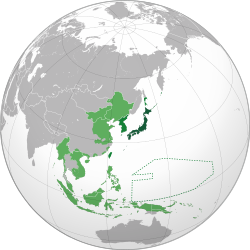சப்பானியப் பேரரசு
 |
இந்தக் கட்டுரை ஜப்பானிய உரையைக் கொண்டுள்ளது. சரியான ஒழுங்கமைவு ஆதரவில்லையெனில், உங்களுக்கு கேள்விக்குறிகளோ, கட்டங்களோ அல்லது மற்ற குறியீடுகளோ கன்சி மற்றும் கனாக்கு பதிலாக தெரியலாம். |
| சப்பானின் வரலாறு |
|---|
 |
|
|
Glossary |
சப்பானியப் பேரரசு (大日本帝国/大日本帝國 டாய் நிப்பான் டெய்கோகு?, பொருள் "பெரும் சப்பானியப் பேரரசு")[7] (Empire of Japan) அரசியலமைப்பின்படியான, நாடாளுமன்ற முடியாட்சி, பேரரசு மற்றும் உலக வல்லமை கொண்ட இராச்சியமாகும்.[5] இது சனவரி 3, 1868இல் மெய்சி மீள்விப்பு காலத்திலிருந்து 1947இல் தற்கால சப்பானின் அரசியலமைப்பு சட்டம் நிறைவேற்றப்படும்வரை அமைந்திருந்தது.

சப்பானியப் பேரரசின் ஃபுகோகு கியோஹை (富国強兵? "நாட்டை செழிப்பாக்கு, படைத்துறையை வலிதாக்கு") முழக்கத்துடன் நிறைவேறிய தொழில்மயமாக்கலும் படைத்துறையாக்கமும் சப்பானை உலக வல்லமை உள்ள நாடாக மாற்றியது; அச்சு நாடுகளுடன் கூட்டு சேர்ந்து ஆசியா - பசிபிக் பகுதியின் பெரும்பாலான நாடுகளை கைப்பற்றியது. 1942இல் சப்பானியப் பேரரசு உச்சநிலையில் இருந்தபோது அதன் ஆட்சிப்பரப்பு 7,400,000 சதுர கிலோமீட்டர்கள் (2,857,000 sq mi) ஆக இருந்தது. இதனால் வரலாற்றிலேயே மிகப் பெரிய கடல்சார் பேரரசுகளில் ஒன்றாக விளங்கியது.[8]
மேற்சான்றுகள்[தொகு]
- ↑ Josephson, Jason Ānanda (2012). The Invention of Religion in Japan. University of Chicago Press. பக். 133. பன்னாட்டுத் தரப்புத்தக எண்:0-226-41234-2.
- ↑ Thomas, Jolyon Baraka (2014). Japan's Preoccupation with Religious Freedom (Ph.D.). Princeton University. p. 76.
- ↑ Jansen 2002, ப. 669.
- ↑ Hunter 1984, ப. 31-32.
- ↑ 5.0 5.1 5.2 "Chronological table 5 1 December 1946 – 23 June 1947". National Diet Library. பார்க்கப்பட்ட நாள் September 30, 2010.
- ↑ One can date the "restoration" of imperial rule from the edict of January 3, 1868. Jansen, p.334.
- ↑ Shillony, Ben-Ami (2013). Ben-Ami Shillony – Collected Writings. Routledge. பக். 83. பன்னாட்டுத் தரப்புத்தக எண்:1-134-25230-7. http://books.google.co.jp/books?id=jQoNuRfzqNMC&pg=PA83&dq=%22Dai+Nippon+Teikoku%22+%22Empire+of+Great+Japan%22&hl=en&sa=X&ei=ZjvRUq-RHsq_kgWqooDICQ&ved=0CCsQ6AEwAA#v=onepage&q=%22Dai%20Nippon%20Teikoku%22%20%22Empire%20of%20Great%20Japan%22&f=false.
- ↑ Bruce R. Gordon (2005). "To Rule the Earth...". Archived from the original on 2007-10-13. பார்க்கப்பட்ட நாள் 2021-08-16. (See "Bibliography". Archived from the original on 2007-10-21. பார்க்கப்பட்ட நாள் 2021-08-16. for sources used.)
குறிப்புகள்[தொகு]
- ↑ Although the Empire of Japan officially had no state religion,[1][2] சிந்தோ played an important part for the Japanese state: As Marius Jansen, states The Meiji government had from the first incorporated, and in a sense created, Shinto, and utilized its tales of the divine origin of the ruling house as the core of its ritual addressed to ancestors “of ages past.” As the Japanese empire grew the affirmation of a divine mission for the Japanese race was emphasized more strongly. Shinto was imposed on colonial lands in Taiwan and Korea, and public funds were utilized to build and maintain new shrines there. Shinto priests were attached to army units as chaplains, and the cult of war dead, enshrined at the Yasukuni Jinja in Tokyo, took on ever greater proportions as their number grew.[3]



